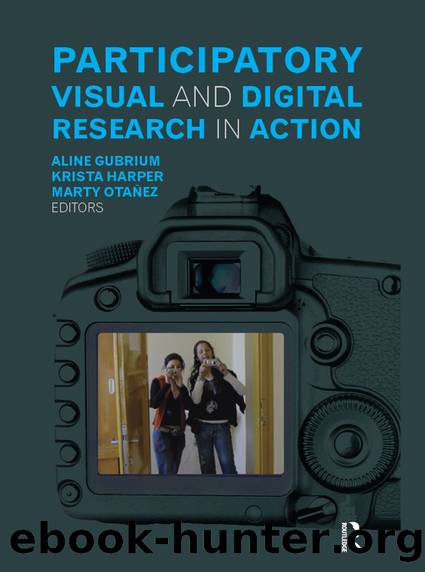Participatory Visual and Digital Research in Action by Aline Gubrium Krista Harper Marty Otañez

Author:Aline Gubrium, Krista Harper, Marty Otañez [Aline Gubrium, Krista Harper, Marty Otañez]
Language: eng
Format: epub
Tags: Nonfiction, Social & Cultural Studies, Social Science, Anthropology
ISBN: 9781315422954
Publisher: Taylor and Francis
Published: 2016-07-01T04:00:00+00:00
A Rural Case Study in Landscape Change and Emotional Wellbeing
At first, the project was designed to focus on identifying and geographically documenting local landownersâ senses of place and the meanings of land and water resources in the face of change. But when landowners began sharing their experiences and expectations about changes related to shale gas developments, they also shared important facets of their rapidly changing emotional lives. Beyond an exploration of place and environmental meanings, this project had the potential to serve as a way for landowners to articulate their personal and collective feelings, experiences, concerns, and uncertainties about how shale gas developments were affecting their emotional wellbeing (Perry 2012a). This presented a unique opportunity to facilitate both a visual and affective exploration of the everyday lives and experiences of rural landowners during a period of rapid environmental and social change.
One of the consistent qualities of the early interviews I conducted were the intense emotions that came to the surfaceâsadness, excitement, anger, greed, jealousyâwhen participants spoke about shale gas developments. However, it was not until I received a phone call from one of the female dairy farmers who had agreed to participate in the focus group that I recognized the role this project could play in documenting local landownersâ emotional wellbeing and psychological lives.
â¦they were afraid that if they signed the new lease, with the nondisclosure clause, and participated [in the focus group] they would be violating the lease and could lose the lease deal, or worse, their farm. She said the money wasnât that important to her, but the farm and her work was what she lived for. Through her tears, she continued by saying âWe are just so stupid,â âWeâll do anything for money,â and âWeâre just all a bunch of dumb farmers up here.â I hung up the telephone feeling shaken and helpless and realizing that this was a turning point in how I was going to conduct this project (Bradford County digital field notes, February 18, 2010).
The way in which locals spoke about the development of the Marcellus Shale and how change was unfolding was revealing perceptions and feelings about self, family, occupation, money, natural resources, neighbors, outsiders, and community. Other researchers and community organizers had turned these highly charged emotional periods of change into transformative and positive experiences. Most important, I embraced the concept of ethnography as a âtherapeutic praxisâ in which individual and community emotions that may be painful or traumatic can be sharedâwith a voice, a picture, a map, a poem, a storyâand in that sharing be released and even transformed (Ainslie and Brabeck 2003). I began to see my fieldwork as not only collecting ethnographic, spatial, public planning, and natural resource data for creating GIS maps and geographically explicit images that represent the relationships between a place and people at a particular time of environmental and social change, but even more urgently as facilitating a process that allowed people to articulate and share their emotional relationships to change.
Download
This site does not store any files on its server. We only index and link to content provided by other sites. Please contact the content providers to delete copyright contents if any and email us, we'll remove relevant links or contents immediately.
Cecilia; Or, Memoirs of an Heiress — Volume 1 by Fanny Burney(32495)
Cecilia; Or, Memoirs of an Heiress — Volume 2 by Fanny Burney(31909)
Cecilia; Or, Memoirs of an Heiress — Volume 3 by Fanny Burney(31893)
The Great Music City by Andrea Baker(31758)
We're Going to Need More Wine by Gabrielle Union(19003)
All the Missing Girls by Megan Miranda(15779)
Pimp by Iceberg Slim(14434)
Bombshells: Glamour Girls of a Lifetime by Sullivan Steve(14022)
For the Love of Europe by Rick Steves(13594)
Talking to Strangers by Malcolm Gladwell(13291)
Norse Mythology by Gaiman Neil(13279)
Fifty Shades Freed by E L James(13187)
Mindhunter: Inside the FBI's Elite Serial Crime Unit by John E. Douglas & Mark Olshaker(9263)
Crazy Rich Asians by Kevin Kwan(9223)
The Lost Art of Listening by Michael P. Nichols(7453)
Enlightenment Now: The Case for Reason, Science, Humanism, and Progress by Steven Pinker(7273)
The Four Agreements by Don Miguel Ruiz(6701)
Bad Blood by John Carreyrou(6583)
Weapons of Math Destruction by Cathy O'Neil(6215)
